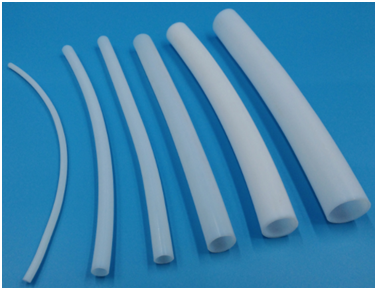PTFE is the most durable plastic known at present. It is widely used in various industries with harsh environments. Due to its excellent performance, it has gradually become the mainstream product in plastic products (The whole is called as Polytetrafluoroethylene). Therefore, there are also more and more manufacturers producing such products. PTFE can be made into many forms of products, such as tubes, rods, plates, gaskets, films, etc., which are used in various fields.

What is PTFE tube?
Polytetrafluoroethylene (abbreviated as PTFE), commonly known as "Plastic King", is a high molecular polymer obtained by polymerizing tetrafluoroethylene as a monomer, which is white or translucent. This material does not contain any pigments or additives, and has the characteristics of acid and alkali resistance, resistance to various organic solvents, and is almost insoluble in all solvents. In addition, PTFE has a wide temperature range and can be used for a long time at -65°C~260°C under normal pressure. It is manufactured by paste extrusion method. PTFE tubing manufactured using paste extrusion is flexible and it can manufacture PTFE tubing with inner diameters as small as 0.3 mm up to a maximum of 100 mm and wall thicknesses as small as 0.1 mm to 2 mm. Therefore, polytetrafluoroethylene (PTFE) tubing is an extremely versatile product that offers a wide range of applications in many different industries.
Why PTFE tubes are widely used:
1. High temperature resistance, insoluble in any solvent. It can withstand high temperature up to 300 °C in a short time, and generally can be used continuously between 200 °C and 260 °C, with significant thermal stability.
2. Low temperature resistance, good mechanical toughness at low temperature, even if the temperature drops to -65 ℃, it will not become embrittled, and it can maintain 5% elongation.
3. Corrosion resistant, inert to most chemicals and solvents, resistant to strong acids and alkalis, water and various organic solvents, can protect parts from any kind of chemical corrosion.
4. Anti-aging, under high load, has the dual advantages of wear resistance and non-sticking. Best aging life in plastics.
5. High lubrication, the lowest coefficient of friction among solid materials. The coefficient of friction changes when the load slides, but the value is only between 0.05-0.15. Therefore, it has the advantages of low starting resistance and smooth operation for making bearings.
6. Non-adhesion is the smallest surface tension of solid materials, and does not adhere to any substances. Almost all substances will not stick to it. Very thin films also show good non-stick properties.
7. It is odorless, tasteless, non-toxic, physiologically inert, and has no adverse reactions when implanted in the body as artificial blood vessels and organs for a long time.
8. Lightweight and flexible. Greatly reduce the operator's work intensity.
Some common uses of PTFE tubes:
1.Chemical Industry
Because of their high chemical resistance to almost all chemicals, PTFE tubes are ideal for use in the chemical industry. This includes the semiconductor industry. Modern processes in semiconductor production require the safe metering and transport of corrosive liquids (acids and bases). These can severely damage the delivery tube in a short period of time.
2. Automobile industry
In a car engine, high-quality tubing made of PTFE is used for fuel evaporation and fuel rails. Such as fuel hoses, turbocharger hoses, coolant hoses, automatic brake hoses, motorcycle brake hoses, diesel engine hoses, racing hoses and power steering hoses. The characteristics of high temperature and low temperature resistance, high pressure resistance, wear resistance and corrosion resistance of PTFE tube make it have a long service life without frequent replacement.
3. 3D printing industry
In 3D printing, the filament should be transferred to the printing nozzle, which must be done in a high temperature range. PTFE tubing is the most preferred polymer in the 3D printing industry due to its high temperature coefficient and non-stick properties, which help slide the material easily from the nozzle.
4.Medical industry
Special properties of PTFE tubes also include an easy-to-clean surface structure. In the past decade, PTFE tubing has been increasingly used in medical devices. Due to the low coefficient of friction of PTFE tubing, it means that it has a very smooth surface that neither masks nor aids bacterial growth. Among them, hoses are used for cannulas, catheters, pipettes and endoscopes.
5. Food industry
Due to its easy cleaning and non-stick properties, PTFE tubing can be used in the food industry. In particular, tubes made of unfilled PTFE are suitable due to their physiological neutrality and comply with US Food and Drug Administration guidelines. Therefore, it has been proven harmless in contact with plastic and any type of food.
Buying the right PTFE tubing is not only about choosing different specifications for different applications. More to choose a reliable manufacturer. Besteflon Fluorine plastic Industry Co., Ltd. specializes in the production of high-quality PTFE hoses and tubes for 15 years. If any questions and needs, please feel free to consult us for more professional advice.
Related Articles
Post time: Aug-13-2022
